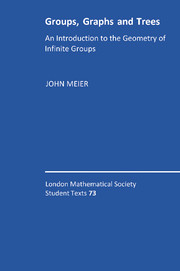Book contents
- Frontmatter
- Contents
- Preface
- 1 Cayley's Theorems
- 2 Groups Generated by Reflections
- 3 Groups Acting on Trees
- 4 Baumslag–Solitar Groups
- 5 Words and Dehn's Word Problem
- 6 A Finitely Generated, Infinite Torsion Group
- 7 Regular Languages and Normal Forms
- 8 The Lamplighter Group
- 9 The Geometry of Infinite Groups
- 10 Thompson's Group
- 11 The Large-Scale Geometry of Groups
- Bibliography
- Index
9 - The Geometry of Infinite Groups
Published online by Cambridge University Press: 05 June 2012
- Frontmatter
- Contents
- Preface
- 1 Cayley's Theorems
- 2 Groups Generated by Reflections
- 3 Groups Acting on Trees
- 4 Baumslag–Solitar Groups
- 5 Words and Dehn's Word Problem
- 6 A Finitely Generated, Infinite Torsion Group
- 7 Regular Languages and Normal Forms
- 8 The Lamplighter Group
- 9 The Geometry of Infinite Groups
- 10 Thompson's Group
- 11 The Large-Scale Geometry of Groups
- Bibliography
- Index
Summary
[E]ssentially all geometric constructs which are global in nature, such as paths of shortest length, global manifestations of curvature, planes, half-spaces, rates of growth, which are studied in differential geometry have manifestations in combinatorial approximations to that geometry.
–James CannonGromov's Corollary, aka the Word Metric
We have seen a number of examples of groups acting on the real line. Sometimes these actions preserve the distance between points on the line, such as the action of D∞. Other actions we have considered do not preserve distances, for example, the action BS(1, 2) ↷ ℝ presented in Chapter 4. One of the most powerful insights in the study of finitely generated infinite groups is that they can always be viewed as groups acting in a distance-preserving way on a geometric object. We refer to this insight as Gromov's Corollary to Cayley's Better Theorem, in honor of a groundbreaking paper that Mikhail Gromov wrote in the 1980s [Gr87], which highlighted this perspective, introduced a number of questions motivated by the geometry of infinite groups, and introduced powerful tools that can be used to answer them.
In order to present Gromov's Corollary, we need to introduce a reasonably flexible notion of “geometric object” as well as formally define what we mean by saying that a group action “preserves distances.”
- Type
- Chapter
- Information
- Groups, Graphs and TreesAn Introduction to the Geometry of Infinite Groups, pp. 162 - 186Publisher: Cambridge University PressPrint publication year: 2008



